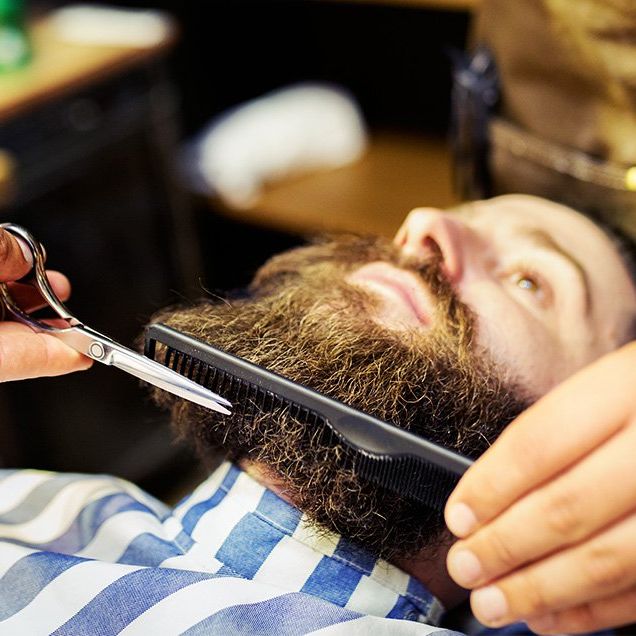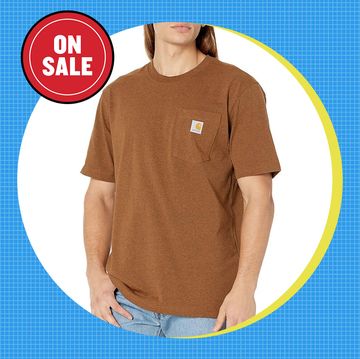There’s an adage about plants: they grow by the inch and die by the foot. There should be one for beards. You shape them for weeks, and then one day you’re just trying to touch up your jaw line with a buzzer, you get a text, and suddenly you’ve mangled your beard trim so badly that you seriously consider shaving the whole thing.
Even in less extreme scenarios, a trim can go wrong. When your beard is long, it can be hard to see exactly where your neck line should be, and suddenly you’ve trimmed it too high. Or you go to a new barber who has a different opinion than you do about where your cheek lines should be, or how thick you should leave your sideburns.
No one knows the natural beard lines of your face better than you do—and that means when something goes wrong, it’s up to you to fix it. First you need to know the rules to shaping a beard (and if you don’t, you can read them here). Then, it pays to have a system for correcting trims gone wrong. Use this process, and getting back your beard shape can be less awkward—or you might avoid these kinds of problems in the first place.
First off, communicate
On the one hand, a good barber is your best defense against having your beard look too “DIY.” But on the other hand, if your barber advocates a different style of beard trim than you like, you’re going to butt heads.
Use your words, and use your hands. Specify how defined you want the edges—or would you rather keep them natural? Point and draw lines with your fingers where you want your beard to end, or give directions in relation to where it is now. (“I want to bring the neck line up a quarter inch, so it’s more centered between my Adam’s apple and chin.”)
Beware of “line creep”
Even with good communication, you may notice that the edges of your beard move inward every haircut—especially if you go to the barber frequently.
"Sometimes this happens with cleaning up neck lines and/or upper cheeks," says Jessica Candia, a hair stylist at Brooklyn's Persons of Interest. "It's easy for these lines to creep up and down. ... Whether it's self-grooming, or miscommunication in the chair—lines that are made or altered have to be given time to grow back in."
If you notice your barber cuts into the back of your beard when trimming around your ears, for instance, don’t be afraid to point it out. You can say, “I’m trying to bring that beard line back toward my ear, so go easy there.”
Go short to grow
What do you do when the lines have moved in too far? Or, worse yet, when you slip up and shave a patch into part of your beard? Go short to go long.
Say your neck line has gotten all out of whack. Use a buzzer on a medium setting to take down the length of your beard overall, then use a slightly shorter setting to taper the edge down to the length of just a few days’ stubble.
Now when you shave your neck, reposition the line where you want it to be. It will be shorter than the hair nearby, but not drastically so. You’ve essentially created a taper, which is the key to growing your beard back without having a harsh boundary between long and short sections.
“Luckily,” says Candia, “it only takes about a week for hard lines to soften and for some hair to grow back.” Trim your beard as usual, and you’ll start to see it all blend together.
Embrace the taper
Creating a taper is the key to growing out mistakes. And having a taper in the first place can give you the flexibility to avoid mistakes.
“If you naturally taper under the neck already, a fade on the neck cleans it up without adding hard lines,” says Candia. Of course, she points out this won’t work with all guys. If your beard connects to your chest hair, you’re going to need to establish more of a boundary.
Still, allowing your beard to grow the way it does naturally keeps maintenance to a minimum—maybe that’s why this style is favored by celebs like Ryan Reynolds and David Beckham. You don’t have to maintain your cheek line on a weekly basis, but if you’re going somewhere nice you can always touch it up.
“Maintaining a natural taper with your facial hair allows room for a softer look,” says Candia, “and you can still do a quick clean up for a more formal one.”
With long beards, seek help
Most of the advice here is for short or medium-length beards. Because, let’s face it, if you screw up the neck line of a lumberjack beard, no one’s going to see it.
But the flip side of the coin is that a long beard can be impossible to groom by yourself. You need the ability to look underneath it. And trimming it requires scissors.
This is a place to get a barber’s help. Find one with expertise in long beards who won’t undo your weeks or months of beard-growing. A safe bet is to ask a friend with a good beard (and if you this beard, you have these friends) where he gets it touched up.
Ask your barber to clean up your neck, while keeping your beard full. You may also want him to use scissors to trim some of the beard length by your ears, so that the back edges fall in line with your sideburns. Plus, he can blend it with your haircut—or create contrast by taking your haircut short on the sides, which will make your beard look fuller.
In the end, regular maintenance of even a long beard will keep the underlying shape in check. Which is helpful, in case you ever slip up and need to take it short again.
(Want to keep up with all the latest grooming products? Check out these must-haves.)













